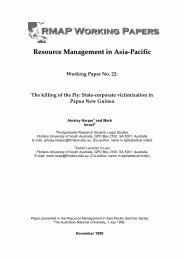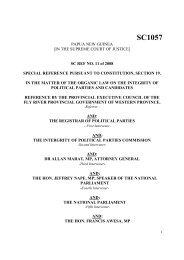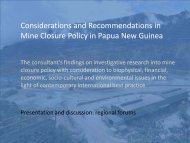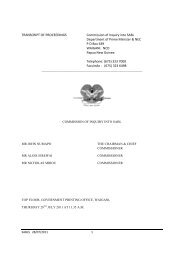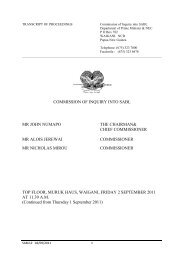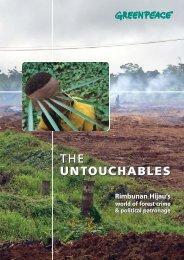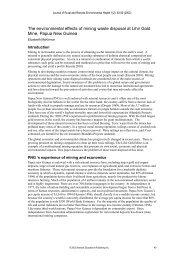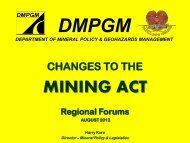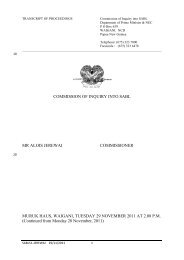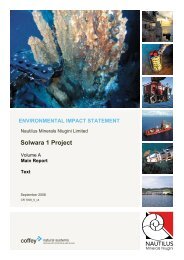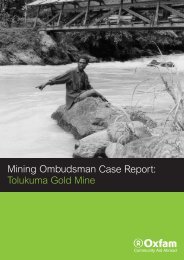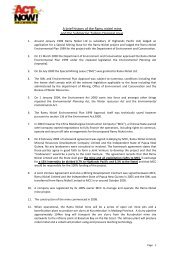might say today. This is certainly an ethos throughout the Sepik region, especially the interiorTorricelli Mountains area where physical and social health are closely related.Since the turn <strong>of</strong> the 20 th Century Kairiru, like most <strong>of</strong> the Wewak <strong>of</strong>fshore islands, has beenheavily missionized by the Catholic church. This has had certain implications for the way localpeople now address the cash economy and new forms <strong>of</strong> wealth. “Many villagers have come tosee superior European wealth as rooted in a superior form <strong>of</strong> harmony and cooperation, and theytend to see such cooperation as having magicoreligious as well as directly instrumental effects,”says Smith. Ibid). Cooperation, harmony, and the New Testament have all become vehicles to amodern lifestyle.To be sure, all Sepik cultures share the ideal <strong>of</strong> cooperation (see Mitchell 1990, for example).<strong>The</strong>se are not like highlands ‘bigmen’ societies where the accumulation <strong>of</strong> clan wealth isspearheaded by a single ambitious and charismatic individual. <strong>The</strong>re are Sepik big men, buttheir authority comes from “heritable rights to esoteric magicoreligious knowledge for control<strong>of</strong> food production, weather, curing, and other areas <strong>of</strong> general concern.” (Smith Ibid:217).Leaders may be as arbitrary or ruthless as highlands bigmen, but the difference is that theirquest is less material, and the community still exerts some control in an effort to maintain groupharmony over any kind <strong>of</strong> intra-group competition.In 1934 Australian anthropologist Ian Hogbin was living on Wogeo (sometimes refered to asVokeo) Island in the Schouten Islands farther <strong>of</strong>fshore from Wewak than Kairiru (se Hogbin1970). If one were to step back from the map <strong>of</strong> PNG and look at the cresecent shape <strong>of</strong> NewIreland and New Britian, you need only follow the western tail to the mainland through theSiassi Islands, to Karkar, Manam and the Schouten Islands <strong>of</strong>f Wewak, all <strong>of</strong> which seem touncoil like the flick <strong>of</strong> a tail. Kairiru and Muschu are much closer to the mainland althoughdefinitely within the same cultural complex as the Schoutens. <strong>The</strong>se are all male initiationsocieties with taro as their staple food. Garden magic, love magic and sorcery are the mainstays<strong>of</strong> authority and preeminence in these societies, although each village and/or clan also has itsheadman. Still, there are not paramount chiefs; they are more like governors than primeministers. It should be noted, however, that even as these are strongly patrilineal societies, thereare matrilineal descent reckoning and women are key players in the social and economy life <strong>of</strong>the community. Girls celebrate first mearch, and boys ritually imitate female menstruation as aform <strong>of</strong> purification by ceremonially incising their tongues and their penises so as to bleed outany ‘bad’ blood. (Hence Hogbin’s book is titled <strong>The</strong> Island <strong>of</strong> Menstruating Men).In the twenties, what looked like an oil source at Matapau, near Angoram on the Sepik River,attracted the first oil exploration in the area, by Ormildah Mining <strong>of</strong> Australia. Although this wasdiscovered to be seepeage from farther inland, Ormildah was followed by Oil Search Limited.<strong>The</strong> first gold prospector in the Sepik District was W.A. MacGregor in 1928. But wasn’t until1934, when J.C. Mullalay, A.H. McHutchinson, B. Costello, and W.L. Heron began dreging onthe Mingim River, two days walk from Wewak, that people started to move up from the Morobefields in search <strong>of</strong> new claims. Eventually the Screw , Siling and Nagum Rivers were also beingdredged. In her forward to District Officer Townsend’s memoir, one miner’s wife, Judy Tudor,writes that. But prospecting was never lucrative in the District.<strong>The</strong> birth <strong>of</strong> gold prospecting also gave impetus to aviation in the District, and work started on anairfield in 1937. At this time Bob Parer arrived in Wewak and set up a freezer works roughlyopposite the present Westpac Bank, where fresh vegetables and imported foods arrived every sixweeks from the Burns Philp ship. At this time the original owner <strong>of</strong> Moem, Boram and Brandi30
plantations, Dick Glasson, sold them <strong>of</strong>f to Burns Philp, and the trade store at Boram, long animportant site for miners who would kit out before going to the fields, became the first BurnsPhilp retail outlet in the region.<strong>The</strong> impact <strong>of</strong> World War II has been the most transformative moment in the East Sepik’s recenthistory. Much has been written about Sepik villagers’ great heroism and suffering during the waryears. Perhaps more important than the war were the social changes that it set in motion.One outcome <strong>of</strong> the wartime experience in Melanesia was that a few forceful and farsightedindividuals returned to their places after the war with visions <strong>of</strong> social, economic, andpolitical change through communal organization and effort….Pita Simogun’s efforts atpromoting cash-cropping in the Wewak-But Boiken area have received some attention. Lesswell known is that in the early postwar years Simogun, Yauwiga, Beibi Yembanda, KokomoUlia, and a number <strong>of</strong> others (many <strong>of</strong> them ex-policemen) mobilized a large part <strong>of</strong> theprovince north <strong>of</strong> the river in a loosely coordinated, development-oirented, generally proadministrationmovement which promoted cash-cropping (especially rice and cacao) andother forms <strong>of</strong> <strong>business</strong> (notably, around Wewak, transport), road building, and education. Atleast some <strong>of</strong> the leaders <strong>of</strong> the movement also challaneged the institution <strong>of</strong> the tambarancult, and this brought them into conflicty with traditional leaders and in some cases earnedthem the suspicious attention <strong>of</strong> administrative <strong>of</strong>ficers. <strong>The</strong> achievements <strong>of</strong> what might becalled “the Simogun Movement” in organizing the planting <strong>of</strong> cash crops were considerable,as was its influence on the administratuon in promoting “development,” but for a variety <strong>of</strong>reasons it failed to satisfy its supporters’ (or leaders’?) expectations <strong>of</strong> substantial monetaryreturns and within a few years gradually declined. (May 1990:177).Despite the initial disappointments <strong>of</strong> these early leaders, it is clear that the Sepik was ready forlarge scale economic change. War hero and dramatic public speaker, Pita Simogun was one <strong>of</strong>only 3 Papua New Guineans nominated by the Administrator, Jack Murray, to sit on theLegislative Council beginning in 1951. In trhe postwar years, Local people were more determinedthan ever to take control <strong>of</strong> development for themselves. For a people dedicated to cooperationand knowledge, the road to total change was obvious:-- education. Like the many Manusians wh<strong>of</strong>ollowed visionary leader Paliau Moloat into some <strong>of</strong> the first provincial schools in the country,Sepik people were predisposed to the educational opportunities <strong>of</strong> the postwar administration. Inthe 1950’s Michael Somare attended Boram School, and by the end <strong>of</strong> the 1950’s he was teachingin Wewak. Settlers were moving in to the area to send their kids to school, but the school itselfcouldn’t expand and was shifted, instead, to Brandi in 1954, where it became a High School.Somare taught grades 7,8 and 9 in 1959 at Brandi along with one other National and sevenexpatriates.[Wewak native] Yauwiga really had a vision for the future <strong>of</strong> the Sepik District, and theBoram School was his method <strong>of</strong> making the vision a reality. He explained what he wanted tothe Kreer people, and [they] gave him some land on which to build a school. <strong>The</strong>re was noway <strong>of</strong> getting back to his home village at Boram other than trekking through the bush soYauwiga sent a message to the village asking for some people to come help him build theschool. <strong>The</strong> villagers who came, who were to form the nucleus <strong>of</strong> the new Kreer Cooperative,helped Yauwiga to build classrooms <strong>of</strong> bush materials firstly on the present site <strong>of</strong>the Kreer Community School and a year later on the present sit <strong>of</strong> the Boram PowerHouse….Yauwiga started a piggery close to the original site at Kreer. <strong>The</strong> money he got fromlooking after other peoples’ pigs was ploughed back into the school and the pigs themselvesmade an occasional change in the diet <strong>of</strong> the children. (Fleetwood 1991:48-9)31
- Page 1 and 2: Fishy BusinessThe social impact of
- Page 3 and 4: 4. Townspeople and market women 158
- Page 6 and 7: More to the point, the contract for
- Page 8 and 9: ‘development’ projects will be
- Page 10 and 11: whole concept of MSY; the problem o
- Page 12: noted most reasonably that the skil
- Page 16 and 17: • That landowners groups be encou
- Page 18 and 19: This project adopted an open protoc
- Page 20 and 21: public figures who had seen RD Tuna
- Page 22 and 23: suddenly costs the government more
- Page 24 and 25: problems of the poor.’ He pledges
- Page 26 and 27: scores of landowner groups who regi
- Page 28 and 29: areas…There were promises of new
- Page 32 and 33: During the 1950’s over 860,000 co
- Page 34 and 35: of reorientation of focus and direc
- Page 36 and 37: But it is the provincial government
- Page 38 and 39: title, sensu the Windjammer, is ‘
- Page 40 and 41: Blue Water Tuna is a private PNG co
- Page 42: 9.5.05: The Bismark Fishing Company
- Page 45 and 46: The two landowning clans of Parom g
- Page 47 and 48: ilong mi na long tingting bilong ol
- Page 49 and 50: ol set ups, say olsem 20 or 30 set
- Page 51 and 52: No contact or awareness with Marien
- Page 53 and 54: Los Angeles, CA 90021USATel: 1-800-
- Page 55 and 56: meters out from its original size,
- Page 57 and 58: The Offshore Masters is going to be
- Page 59 and 60: I am not aware of any Environmental
- Page 61 and 62: “Based on the 970 local labour re
- Page 63 and 64: Water Resources Act (Chapter No. 20
- Page 65 and 66: The 26 Local Level Governments in t
- Page 67 and 68: people were made to believe that ne
- Page 69 and 70: Nianguma, so the leaders of the 8 c
- Page 71 and 72: 3. That there was a totally unbeara
- Page 73 and 74: p10:p12:73
- Page 75 and 76: p.14:75
- Page 77 and 78: . Marine Ripples articleThe followi
- Page 79 and 80: In general, I feel SSTC has present
- Page 81 and 82:
•how the tuna factory development
- Page 83 and 84:
Responses to Consent Condition Exce
- Page 85 and 86:
“Sometimes while working we are t
- Page 87 and 88:
fisheries myself at one stage and f
- Page 89 and 90:
N: “Have you sponsored sporting g
- Page 91 and 92:
never cleaned fish before, that was
- Page 93 and 94:
IB: “Oh sure, but somebody’s go
- Page 95 and 96:
Philomena Naura: “The smell aroun
- Page 97 and 98:
There is no covering to the oxidizi
- Page 99 and 100:
Above: four consecutive pay slips f
- Page 101 and 102:
Above is a list of curses said to b
- Page 103 and 104:
duties on one of the ships offloadi
- Page 105 and 106:
on the side of the fishing vessel.
- Page 107 and 108:
The fishery observer told us that i
- Page 109 and 110:
Speaking of prostitution on fishing
- Page 111 and 112:
and if any major disruptions occur
- Page 113 and 114:
Most of us here are very unfortunat
- Page 115 and 116:
The husband of the woman employed a
- Page 117 and 118:
Thomas Nigints was one of the few p
- Page 119 and 120:
Did SST place FADs in the sea?The c
- Page 121 and 122:
doing it, it’s going to be over o
- Page 123 and 124:
Landowners are also deeply disturbe
- Page 125 and 126:
places or settlement where they are
- Page 127 and 128:
in the revenue, so when the opportu
- Page 129 and 130:
And as soon as they’d finished th
- Page 131 and 132:
There is no legal case as yet with
- Page 133 and 134:
owns the land legally and therefore
- Page 135 and 136:
There is still need to recruit more
- Page 137 and 138:
In regard to the production, by the
- Page 139 and 140:
The company invited interested peop
- Page 141 and 142:
strategy is very well used by forei
- Page 143 and 144:
employees and those whose work requ
- Page 145 and 146:
The present Human Resource Manager
- Page 147 and 148:
working gear? In my section I wear
- Page 149 and 150:
working for a whole first week with
- Page 151 and 152:
Serah from Manam island, married wi
- Page 153 and 154:
stret long mipela ol mama husait I
- Page 155 and 156:
The supervisors in the plant/engine
- Page 157 and 158:
The color of the sea has changed. F
- Page 159 and 160:
Donald Jacob, Catrans fuel distribu
- Page 161 and 162:
Kapmandu Service station. Did South
- Page 163 and 164:
Three women involved with roadside
- Page 165 and 166:
export processing zones and then in
- Page 167 and 168:
When we asked if this meant sportin
- Page 169 and 170:
then men’s. Usually they’re exc
- Page 171 and 172:
The WWF consultant also notes that
- Page 173 and 174:
of a company like SST cannot be pla
- Page 175 and 176:
East Sepik Governor Arthur Somare s
- Page 177 and 178:
The cost of the project is between
- Page 179 and 180:
The National Shipping Page, 1.6.04W
- Page 181 and 182:
that have similar fish factory set-
- Page 183 and 184:
Infofish website : PNG: Tuna export
- Page 185 and 186:
Post-Courier 20.6.05185
- Page 187 and 188:
Did your application form ask you a
- Page 189 and 190:
Do you know whether the Provincial
- Page 191 and 192:
The Provincial AdministratorDept. o
- Page 193 and 194:
4. Human Resources registerees, Kew
- Page 195 and 196:
195
- Page 197 and 198:
Under Spin-Off Business Activities
- Page 199 and 200:
Finally, Honourable Ministers, Memb
- Page 201 and 202:
The adverse non-immune (toxic) and
- Page 203 and 204:
low income) will have an impact in
- Page 205 and 206:
ed and pink plastic roses are every
- Page 207 and 208:
207
- Page 209 and 210:
Tuna fisheriesThe management system
- Page 211 and 212:
• Monitor interactions between th
- Page 213 and 214:
Programme is expanding this program
- Page 215 and 216:
This office recommends that, since
- Page 217 and 218:
commercial industry still deny any
- Page 219 and 220:
219
- Page 221 and 222:
221
- Page 223 and 224:
REPORTER: If you come and you put t
- Page 225 and 226:
Berman, M. 1997. Faust, the First D
- Page 227 and 228:
Lutkehaus, N., C. Kaufman, W.E. Mit



